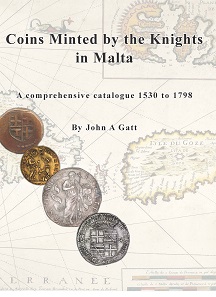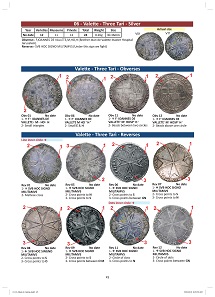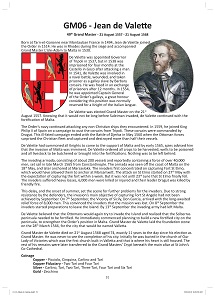by Ursula Kampmann
Translated by Leonie Schulze
September 6, 2018 – Numismatics is something very special. It can become a passion conducive to a more fulfilling and meaningful life. It connects people who did not know each other before and overcomes even the greatest distances. That is the only way one can explain how an Australian, who moved from Malta to Australia with his family in 1951, compiled a corpus of Maltese coins that will replace the standard catalog by Restelli & Sammut from 1977. John A. Gatt flew countless kilometers to put together the vast amount of material. He collected 16,600 coins to compile a catalog which claims to be a type corpus but really is a die corpus.
John Gatt, Coins Minted by the Knights in Malta. A comprehensive catalogue 1530 to 1798. Melbourne 2018. 427 pp., fully illustrated in color. Hardcover. 21.7 x 30.6 cm. ISBN: 978-0-646-98799-6. 200 euros plus shipping.
What is the difference between a type corpus and a die corpus?
Let us briefly talk about the theoretical background (I’m sorry, but sometimes that’s necessary): A type corpus is a catalog which looks at more than just varieties of dies and analyzes the most important types of an issue. Typical type corpora are the good old Davenport, Krause’s World Coins before 1900, or the HMZ catalog of Swiss coins. As a matter of fact, 99% of all catalogs dealing with Medieval coins or coins of the modern period are type catalogs. Prior to the introduction of mechanical coinage, which allows for identical dies, dies had to be cut manually. Thus, it requires a great deal of effort to collect all of the dies of one issue.
A work compiled with this much effort does not seem necessary regarding coins of the early modern period as we require die corpora mainly to answer two questions: we can use them to determine the amount of minted coins (in short: many dies – many coins), and we can compile a relative chronology of coins due to the combination of obverse and reverse dies.
Regarding the number of coins of the early modern period we rely on archives. And the year of issue depicted on the coin is more accurate than die combinations could ever date.
Where do varieties of dies end and types begin?
Of course, it is not always easy to determine what is considered a variety of a coin design. Did the die cutter merely decide to rearrange the letters a bit? Or does the amount of dots in the exergue tell us something about what team was responsible for which group of coins? Is the use of a different type of cross a coincidence or can it be accounted for by chronological differences?
A die corpus of coins minted by the Knights of Malta
The coinage of early modern times is not documented well enough for us to not want to resort to a die corpus every now and then. And we can do that now when researching Maltese coinage because John A. Gatt has unintentionally provided a die corpus. By using small red arrows and comments next to every single coin, he even indicates what we should pay attention to in order to identify the die of a specific coin.
The structure of Gatt’s catalog
The author has rigorously structured his heavyweight book: every grand master was assigned his own number and a respective list of all coins minted in his name. As an introduction, Gatt provides the name, portrait, coat of arms, reign, vita, and the denominations issued under the respective ruler.
This is followed by the catalog. You absolutely have to read the introduction before using it! Because it is structured differently than what we are used to from type and die catalogs. First, the ascertained coins are listed in their entirety including the average diameter and the average weight. Next up are images of the obverse and reverse of coins without descriptions but with a note indicating differences to other obverses and reverses of identical type. A conclusive table lists the “coin numbers”, i.e. the number of the die combination of obverse and reverse – consisting of the number of the grand master, the number of ascertained pieces (subdivided according to museums and private collections), average weight and average diameter.
The author has done unbelievably good work – and still, a numismatist is close to tears thinking about how much of his work did not make it into the book and will thus not be left to scholarly posterity. Instead of actually listing every single specimen and consequently making it possible to reconstruct the provenance of all Maltese coins, the author decided to provide a summary and to treat the different dies as varieties. Those who want to write the next catalog on Maltese coins 50 years from now will have to start from scratch and cannot build on the accomplishments of John A. Gatt. What a waste!
Not to mention, it is not legally unobjectionable for an author to use pictures owned by auction houses without stating where he got the pictures.
An appeal to the author
Therefore, dear author, please do complete your catalog by publishing a short, unillustrated brochure stating in which museum or private collection, in which auction or on which website you found the specimens listed in the “Qty M/P” category – and please include the weight and die axis your wife listed so meticulously. This book you created is great, but such an addition would turn it into a book that all scholars who want to devote themselves to the coinage of Malta can build on.
“Coins Minted by the Knights in Malta” demonstrates two things. First of, the enthusiasm that exists among coin collectors. They are imbued with their passion and capable of doing things in their spare time that hardly any scholars would be willing to do.
On the other hand, this book is indicative of the disparity of academic researchers and collectors. Everyone who has ever taken an introductory seminar on the classification of ancient coins should know what the different forms of a catalog look like and what data is required to compile them. There is a reason why there are accepted ways of doing this.
How is it possible that John Gatt visited 26 internationally renowned coin cabinets while doing his research and no one called him on the technical details of a catalog? If only to make sure their own coins could be found in the catalog, which is not possible in this current version!
It is good that today’s technological standards make it easy to produce amendments. Dear author, I interpret your work as being the first volume that will soon be followed by a second volume including a list appropriately assigning every piece used in this die catalog.
I do not have to specifically point out that everyone who wants to describe the coins of the Order of Malta according to the latest state of research needs to purchase this book.
John A. Gatt runs a corresponding website where you can find high resolution images of the coins shown in the book.
You can also order to book off of this website.






